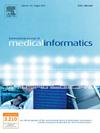Development and validation of a nomogram to predict the risk of in-hospital MACE for emergence NSTE-ACS: A retrospective multicenter study based on the Chinese population
IF 3.7
2区 医学
Q2 COMPUTER SCIENCE, INFORMATION SYSTEMS
International Journal of Medical Informatics
Pub Date : 2025-03-22
DOI:10.1016/j.ijmedinf.2025.105884
引用次数: 0
Abstract
Purpose
Our study aims to develop and validate an effective in-hospital major adverse cardiovascular events(MACE) prediction model for patients with emergency Non-ST elevation acute coronary syndrome(NSTE-ACS).
Methods
We retrospectively collected NSTE-ACS patients in three tertiary hospitals in Chongqing. In-hospital MACE was the predicted outcome. Patients from one hospital were divided into training set and internal validation set according to the ratio of 7:3. Besides, 662 patients from two other tertiary hospitals were for external validation. Patient information including demographics, laboratory tests results and disease course records were for comprehensive analysis. Finally, LASSO were used to identify the predictors and develop the model. This model was subsequently visualized as a nomogram, followed by both internal and external validations.The receiver operating characteristic curve, calibration curve and clinical decision curve analysis were used to assess the model’s discrimination, calibration and clinical applicability, respectively.
Results
A total of 3,308 patients were included, 375 of whom developed in-hospital MACE. The LR model demonstrated that length of stay, neutrophils, myoglobin, NYHA, CCI, NT-proBNP, LVEF and respiratory failure were risk factors for in-hospital MACE in emergence NSTE-ACS patients. In the training set, the AUC was 0.860 (95%CI:0.831–0.889). In external validation,the AUC was 0.855(95%CI:0.808–0.902), and both the calibration curve and DCA in validation set also revealed stable predictive accuracy and clinical validity.Additionally, it is available to calculate the MACE risk online via the web page (https://cocozhou99.shinyapps.io/DynNomapp/).
Conclusion
The prediction model we constructed has good predictive performance and can help healthcare professionals accurately assess the risk of in-hospital MACE in emergence NSTE-ACS patients.
预测急诊NSTE-ACS住院MACE风险的nomogram发展和验证:一项基于中国人群的回顾性多中心研究
目的:建立并验证急诊非st段抬高急性冠脉综合征(NSTE-ACS)患者院内主要不良心血管事件(MACE)预测模型。方法回顾性收集重庆市三所三级医院的NSTE-ACS患者。院内MACE是预测结果。将某医院的患者按7:3的比例分为训练集和内部验证集。此外,还有另外两家三级医院的662名患者接受外部验证。患者信息包括人口统计、实验室检测结果和病程记录进行综合分析。最后,利用LASSO识别预测因子并建立模型。这个模型随后被可视化为一个nomogram,然后是内部和外部的验证。采用受试者工作特征曲线、校准曲线和临床决策曲线分析分别评价模型的判别性、校准性和临床适用性。结果共纳入3308例患者,其中375例发生院内MACE。LR模型显示住院时间、中性粒细胞、肌红蛋白、NYHA、CCI、NT-proBNP、LVEF和呼吸衰竭是急诊NSTE-ACS患者院内MACE的危险因素。在训练集中,AUC为0.860 (95%CI: 0.831-0.889)。外部验证的AUC为0.855(95%CI:0.808 ~ 0.902),验证集的校准曲线和DCA均显示出稳定的预测准确性和临床效度。此外,还可以通过网页(https://cocozhou99.shinyapps.io/DynNomapp/)在线计算MACE风险。结论构建的预测模型具有较好的预测性能,可帮助医护人员准确评估急诊NSTE-ACS患者院内MACE风险。
本文章由计算机程序翻译,如有差异,请以英文原文为准。
求助全文
约1分钟内获得全文
求助全文
来源期刊

International Journal of Medical Informatics
医学-计算机:信息系统
CiteScore
8.90
自引率
4.10%
发文量
217
审稿时长
42 days
期刊介绍:
International Journal of Medical Informatics provides an international medium for dissemination of original results and interpretative reviews concerning the field of medical informatics. The Journal emphasizes the evaluation of systems in healthcare settings.
The scope of journal covers:
Information systems, including national or international registration systems, hospital information systems, departmental and/or physician''s office systems, document handling systems, electronic medical record systems, standardization, systems integration etc.;
Computer-aided medical decision support systems using heuristic, algorithmic and/or statistical methods as exemplified in decision theory, protocol development, artificial intelligence, etc.
Educational computer based programs pertaining to medical informatics or medicine in general;
Organizational, economic, social, clinical impact, ethical and cost-benefit aspects of IT applications in health care.
 求助内容:
求助内容: 应助结果提醒方式:
应助结果提醒方式:


